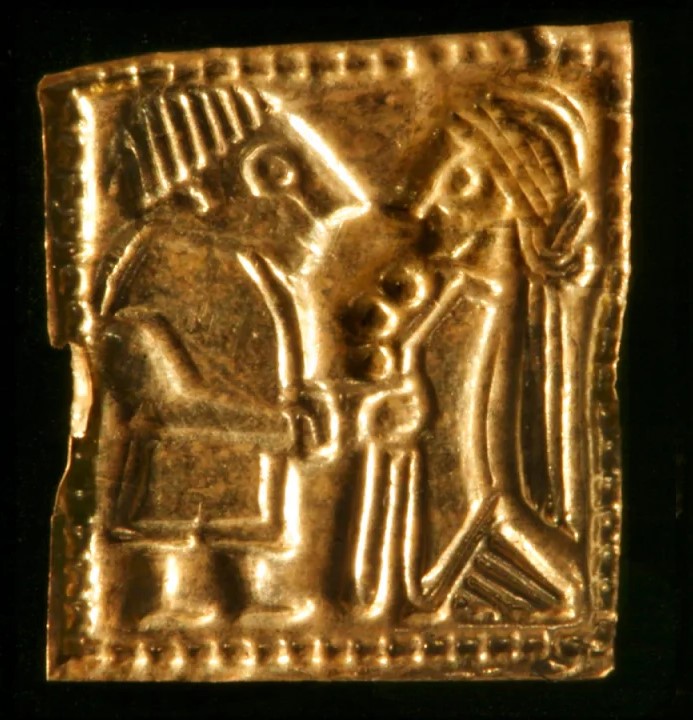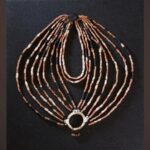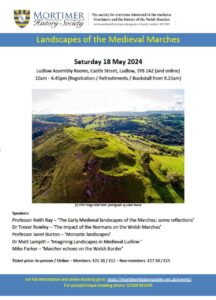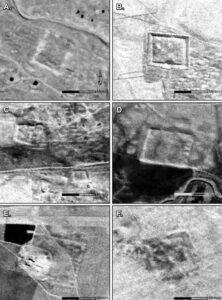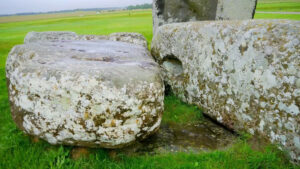Mysterious gold foil figures found in Norway Date: 12 October 2023 Source: CNN
Archaeologists have unearthed five intricate gold foil figures, each less than 1 centimeter tall, in Hov, Norway. These treasures, discovered during excavations of a pagan religious temple, are believed to provide insights into Scandinavian life over 1,400 years ago. While Norway has only ten known sites with such foils, Hov boasts the most, with a total of 35 pieces discovered. These figures, known as “gullgubber”, are predominantly found in Scandinavia and depict men, women, and animals, often adorned with symbols of wealth or possibly representing deities from Norse mythology. The recent finds, which feature a man in a short robe and a woman in a long gown with jewelry, are believed to reflect the costume customs of the time. The gold foils, despite their small size, are considered valuable both for their material and their intricate craftsmanship, symbolizing status and power. Read more…

Scientists say they’ve confirmed evidence that humans arrived in the Americas far earlier than previously thought Date: 05 October 2023 Source: CNN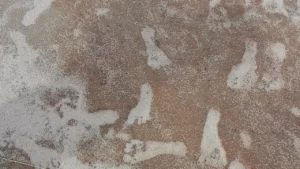
The revelation of fossilized footprints in New Mexico in 2021 was a groundbreaking moment in archaeology, suggesting a new chapter in human history. These footprints, believed to have been made 21,000 to 23,000 years ago, significantly altered the perceived timeline of human settlement in the Americas. While some archaeologists were skeptical about the age of these footprints, recent research has provided further evidence supporting the initial dates. The footprints, found in White Sands National Park, indicate that humans might have arrived in North America before massive ice sheets would have blocked their path. This discovery challenges existing theories about the migration of early humans to the Americas, suggesting they might have settled much earlier than previously believed. Read more…
Scientific breakthrough confirms how early man left Africa 84,000 years ago Date: 03 October 2023 Source: The Independent
A study has unveiled the route early humans took when departing Africa approximately 84,000 years ago. Scientists from the University of Southampton have identified a “well-watered corridor” of river channels spanning the Sinai peninsula and continuing through Jordan as the pathway early humans followed towards Europe and Asia. This conclusion was drawn from the examination of hand tools located near ancient river channels that have since dried up. Dating techniques revealed these tools were likely utilized around 84,000 years ago. The findings suggest that Homo sapiens navigated along these river channels through the Jordan Rift Valley, departing from Africa and heading towards Eurasia. The research emphasizes the significance of small wetlands as essential stopover points during this migration. Read more…
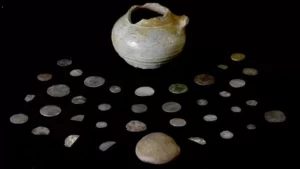 Coin hoard could be linked to 1692’s Glencoe Massacre Date: 09 October 2023 Source: BBC News
Coin hoard could be linked to 1692’s Glencoe Massacre Date: 09 October 2023 Source: BBC News
Coins discovered beneath a fireplace might have been concealed by a victim of the notorious Glencoe Massacre. In February 1692, nearly 40 members of Clan MacDonald of Glencoe were slain after soldiers received orders to assault them. The coins were found at a site associated with the clan’s chief, Alasdair Ruadh “MacIain” MacDonald of Glencoe, who was among those killed. The 36 coins, dating from the late 1500s to the 1680s, were inside a pot with a pebble lid, placed under a hearth stone slab. Archaeologists believe the coins were likely hidden for safekeeping either just before or during the massacre. The discovery offers a unique insight into the events surrounding the massacre and the lives of those affected. Read more…
Archaeologists uncover rare 18th-century cold bath under Bath Assembly Rooms Date: 08 October 2023 Source: The Guardian
Long before the modern trend of ice baths and cold water immersion, the therapeutic benefits of such practices were recognized. Recent archaeological excavations beneath the 18th-century Bath Assembly Rooms have unveiled what might be a unique cold bath of its era. In the 18th and 19th centuries, assembly rooms were hubs for entertainment, dancing, and socializing. While spa towns like Bath were renowned for their hot mineral waters, cold bathing was also recommended by medical professionals for various ailments. The discovery at the Bath Assembly Rooms suggests an exclusive cold bath experience for the elite. The Bath Assembly Rooms, completed in 1771, were known to have a “commodious cold-bath” among other amenities. The recent excavation revealed the bath in its entirety, along with adjacent dressing rooms. This discovery provides a rare glimpse into the leisure practices of the 18th century. Read more…
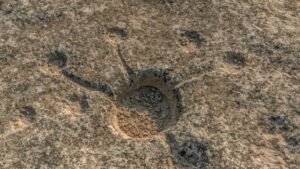 The mysterious symbols found carved in Qatar’s desert Date: April 10, 2023 Source: CNN
The mysterious symbols found carved in Qatar’s desert Date: April 10, 2023 Source: CNN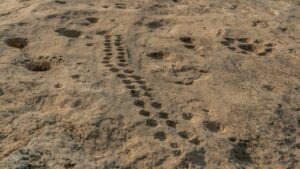
In a remote corner of Qatar’s northeastern coast, amidst the sand dunes, lies Al Jassasiya, the country’s most significant rock art site. Here, ancient inhabitants carved symbols, motifs, and objects onto limestone outcrops, reflecting their environment and experiences. Archaeologists have identified approximately 900 rock carvings or “petroglyphs” at this site. These engravings range from mysterious cup marks arranged in patterns to detailed depictions of sailing ships. Some of the carvings at Al Jassasiya are distinct and not found elsewhere in the Arabian Peninsula. The boat carvings, in particular, offer insights into the fishing and pearling industries that once thrived in Qatar. While the exact age and purpose of these petroglyphs remain a subject of debate, they stand as a testament to the rich history and cultural heritage of the region. Read more…
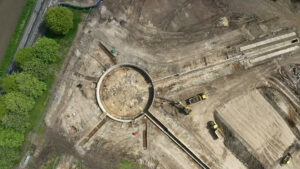 World War Two experimental catapult unearthed by archaeologists Date: 11 October 2023 Source: BBC News
World War Two experimental catapult unearthed by archaeologists Date: 11 October 2023 Source: BBC News
Archaeologists have uncovered an experimental catapult designed for launching World War Two bomber planes. This prototype, named the Royal Aircraft Establishment Mark III Catapult, was discovered at the Harwell Science and Innovation Campus in Oxfordshire. The catapult was developed between 1938 and 1940, during the time the site was RAF Harwell, to facilitate take-offs on shorter runways and allow planes to carry more fuel. However, the project was abandoned as the engines would wear out quickly and the design wasn’t compatible with the bomber planes. The technology was a precursor to Catapult Armed Merchant (CAM) ships, which later launched Hawker Hurricanes at sea using rocket-propelled catapults. The Museum of London Archaeology (MOLA) has created a 3D digital replica of the remains, preserving its historical significance. Read more…
Archaeologists find fresco of three-headed beast in ‘untouched’ Roman tomb Date: 10 October 2023 Source: The Telegraph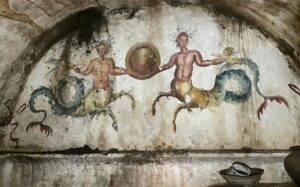
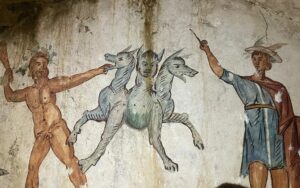
Archaeologists have made a remarkable discovery of an ancient Roman burial chamber adorned with images of Cerberus, the mythical three-headed hound of Hades. The exploration team expressed their profound emotion as they became the first people to enter this burial chamber near Naples in over 2,000 years. A painting of Cerberus, which is a significant figure in Roman mythology, stands prominently on one wall of the chamber. The presence of such a fresco in the tomb provides valuable insights into the cultural and religious beliefs of the Romans during that era. Read more…
Over 10,000 pre-Columbian earthworks are still hidden in the Amazon, study finds Date: October 10, 2023 Source: CNN

Deep within the Amazon rainforest, archaeologists have unveiled 24 previously unknown pre-Columbian earthworks. These ancient remnants of human habitation, preserved as ditches, paths, and wells, sometimes form geometric patterns and were created by indigenous peoples between 500 to 1,500 years ago. The discovery was made possible through the use of lidar, a remote sensing method that generates 3D maps of the landscape. The study, which combined lidar with records of Amazonian tree distribution, suggests that there could be over 10,000, possibly even more than 23,000, such earthworks hidden beneath the Amazon’s canopy. This research not only sheds light on the rich history of the region but also emphasizes the importance of Indigenous knowledge and territorial rights. Read more…
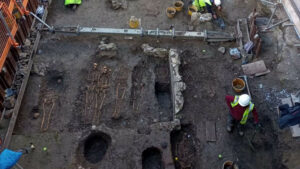 Concerns discovery of human remains led to ‘overspend’ at £6m food market site Date: 12 October 2023 Source: ITV News
Concerns discovery of human remains led to ‘overspend’ at £6m food market site Date: 12 October 2023 Source: ITV News
A year after the discovery of human remains at the former Ocky White department store site in West Wales, concerns have arisen regarding the total expenditure on the new food market project. Archaeologists unearthed the remains of 280 individuals while excavating a medieval friary beneath the site in Haverfordwest, paving the way for the £6m venture. The Dyfed Archaeological Trust initiated excavations at Bridge Street following the detection of human remains during demolition activities. The ruins are believed to be from St Saviour’s Friary, established by a Dominican order in the 13th century and operational until the 16th century. Notably, about half of the skeletons found in this ancient burial site were children’s. Some members of the Pembrokeshire County Council are apprehensive that the discovery might have resulted in budget overruns for the project. This issue is set to be discussed in an upcoming council meeting. Read more…
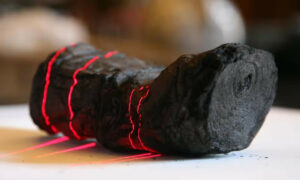 Researchers use AI to read word on ancient scroll burned by Vesuvius Date: 12 October 2023 Source: The Guardian
Researchers use AI to read word on ancient scroll burned by Vesuvius Date: 12 October 2023 Source: The Guardian
In a significant breakthrough, researchers have utilized artificial intelligence to decipher the first word from an ancient scroll that was charred during the eruption of Mount Vesuvius in AD79. The scrolls, which were believed to be irretrievably damaged, were discovered in Herculaneum, a Roman town buried under ash and pumice. The Vesuvius challenge, initiated in March and backed by Silicon Valley investors, aimed to accelerate the reading of these texts. Two computer science students, Luke Farritor in Nebraska and Youssef Nader in Berlin, successfully identified the ancient Greek word “πορφύραc”, translating to “purple”. This discovery has ignited hopes of uncovering more texts from the only intact library from antiquity, potentially revealing lost works and historical documents. Read more…
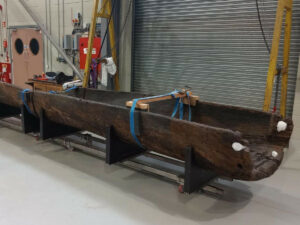 Bronze Age logboat moves into new home after conservation work Date: 12 October 2023 Source: Express & Star
Bronze Age logboat moves into new home after conservation work Date: 12 October 2023 Source: Express & Star
A 3,000-year-old logboat, discovered on the banks of the river Tay, has been relocated to its new home at the Perth Museum after undergoing extensive conservation work. The Bronze Age vessel, known as the Carpow Logboat, was initially reported in 2001 and excavated in 2006. It spent six years at the National Museums Scotland Collection Centre in Edinburgh for stabilization and drying. The boat, carved from a single 400-year-old oak tree trunk, is believed to be one of the oldest and best-preserved of its kind in Scotland. The vessel’s preservation is attributed to the peaty soil composition of the Perth and Tay Estuary area. Experts suggest the boat could have served various purposes, from cargo transport to ritualistic offerings. The museum, housed in Perth’s former City Hall, is set to open next year after a £26.5 million redevelopment project. Read more…
 Parthenon sculptures were once elegantly painted with ‘Egyptian blue’ Date: 12 October 2023 Source: CNN
Parthenon sculptures were once elegantly painted with ‘Egyptian blue’ Date: 12 October 2023 Source: CNN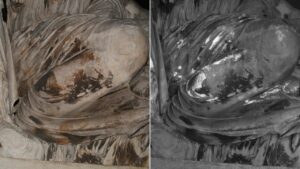
Classical Greek marble sculptures, which are predominantly perceived as pristine white today, were once adorned with vibrant colors and intricate designs. A recent study has revealed that the renowned Parthenon sculptures, dating back 2,500 years, were painted with floral patterns and other elaborate motifs. The technique used to find the paint was created in 2007 by Verri and is known as visible-induced luminescence imaging. The process uses infrared light that finds microscopic traces of paint that the eye cannot see. Researchers identified traces of paint on 11 out of 17 figures. Among the colors detected was “Egyptian blue”, a pigment made from calcium, copper, and silicon, which was reserved for depictions of royalty or deities. This blue was found on various parts of the sculptures, including the serpent tail of the mythical king Kekrops and the garment of Dione, Aphrodite’s mother. The study underscores the significance of color in ancient Greek art and challenges the conventional belief of plain white classical art. Read more…
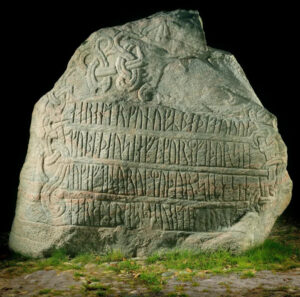 Runestones from Denmark praising a Viking queen hint at her power Date: 14 October 2023 Source: CNN
Runestones from Denmark praising a Viking queen hint at her power Date: 14 October 2023 Source: CNN
Over a millennium ago, in present-day Denmark, artisans carved runestones as tributes to Viking leaders, detailing their accomplishments. Two distinct sets of these runestones mention a woman named Thyra. Recent analysis indicates that both sets of stones were inscribed by the same craftsman and refer to the same individual: a formidable Viking queen. Using 3D scans, researchers from Denmark and Sweden discerned that the carvings on both sets of stones bore the hallmark of the same artisan. The repeated reference to Thyra, especially given the rarity of Viking-era women being mentioned, suggests she was a potent ruler, possibly instrumental in the formation of the Danish realm. This discovery adds to the growing body of evidence that Viking women held significant roles not only in warfare but also in governance and statecraft. Read more…

